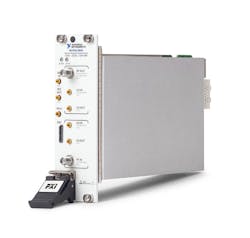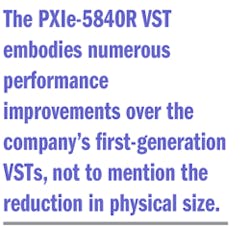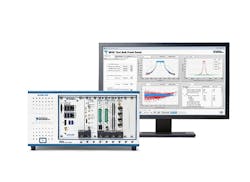This file type includes high resolution graphics and schematics when applicable.
Modular test systems can require some imagination, especially in terms of how much measurement functionality is possible in such little space. With PXIe instrument modules, for example, a test system with signal generators and analyzers occupies a fraction of the volume of traditional “one-box” instruments. What used to occupy a full 19-in. rack can now fit right beside a desktop or laptop computer on a workbench. The first-generation model PXIe-5644R vector signal transceiver (VST) from National Instruments was impressive, fitting a test system within three PXIe slots. The firm’s second-generation model PXIe-5840 VST is even more amazing, extending frequency, bandwidth, and overall performance of the first-generation VST in 33% less volume (just two PXIe slots) while adding a fifth virtual instrument, a high-speed serial bus. What was once a large rack of instruments is now a handful of measurement power.
As with the first-generation PXIe-5644R VST, the new PXIe-5840 VST (Fig. 1) requires a new way of thinking about test equipment and electronic systems in general. In terms of functionality and performance, the new VST is loaded, with a 1-GHz instantaneous analysis bandwidth that can be tuned from 9 kHz to 6.5 GHz. Comparing the PXIe-5840R VST to a traditional signal analyzer, even to a portable spectrum analyzer, makes it clear that this is a significant engineering innovation. It is a complete hardware system that fits within a pair of PXIe chassis slots—and a large part of that volume is devoted to heat sinking and thermal management. The PXIe-5840 VST includes a fast-switching signal generator/transmitter and wideband receiver or analyzer as well as a user-programmable field-programmable gate array (FPGA) and a high-speed digital interface that allows the rapid transfer of data for diverse applications, from signal and channel monitoring to research and/or production test-and-measurement use.
In many ways, the PXIe-5840R VST is the logical conclusion of combining a PC with a system-level approach to test and measurement. The PXIe module contains the usual input and output test ports found on a one-box instrument, including for reference oscillators and local oscillator (LO) signals as needed for frequency upconversion and downconversion of signals of interest. But there are none of the bells and whistles that usually crowd the front panel of a conventional one-box analyzer, such as the switches, buttons, and knobs that are normally part of setting levels and controlling an analyzer and the built-in display screen to show captured signals (and noise). Instead, control and adjustments take place on a PC or other computing device and results are shown on a PC screen. The PC or other computing device orchestrates the measurement functions by running suitable measurement/monitoring software, such as the popular LabVIEW system-design software from National Instruments.
By drawing upon the flexible LabVIEW software for measurement definition, the test capabilities of the PXIe-5840R VST can be redefined in the time it takes to change settings in software or download an example application from a library of programs compiled by the growing LabVIEW user base. The beauty of the PXIe modular instrument format is its ease in expanding a test system’s inputs and outputs, by adding modules to a chassis. This can be particularly useful for applications such as testing antenna arrays or multiple-input, multiple-output (MIMO) antenna systems. When a device under test (DUT) is for an existing communications standard, such as Bluetooth or Wi-Fi, more than likely the required set of measurements for compliance to that standard can be found ready for download in the LabVIEW software library.
Saving Time and Space
In addition to the compact footprint provided by PXIe systems, there is also an associated savings of time in setting up a system for a particular measurement. For multiple-channel, phase-sensitive measurements, for example, which would normally require great attention to a choice of properly phase-matched coaxial cables maintained within a controlled-temperature environment, the interconnections in a PXIe system take place on the measurement chassis backplane, with the tight tolerances for amplitude, phase, and timing synchronization among multiple test channels already defined by the PXIe backplane specifications.
Admittedly, some engineers may prefer the simplicity of a single box, such as a digital storage oscilloscope (DSO) and a trusted set of probes, over the almost unbounded measurement capability afforded by a software-driven, modular system built around the PXIe-5840R VST. For troubleshooting or simple measurements, a one-function box offers the simplicity of a limited set of measurement options. But as modern electronic components grow in complexity and continue to integrate functionality within smaller package sizes, measurements also grow in complexity. Having a large part of an automatic-test-equipment (ATE) system block diagram within two slots of a PXIe chassis, such as with the PXIe-5840R VST, erases questions about finding the right test signal source or if the test signal level is sufficient for properly evaluating passive components, such as filters.
The PXIe-5840R delivers a healthy amount of vector signal generator (VSG) power, typically +23 dBm continuous-wave (CW) power at 1 GHz or about 10 dB more power than the first-generation VSTs. The PXIe-5840R’s vector signal analyzer (VSA) boasts ±0.35 dB amplitude accuracy in its measurements for highly accurate gain and loss measurements. With the growing complexity of RF-related measurements for wireless mobile devices, the PXIe-5840R can deliver data in a hurry, with better than 200 μs frequency tuning speed or a better than 33% improvement in tuning speed over the first generation.
Availability of an instrument module like the PXIe-5840R tends to blur any distinction between what is a test instrument and what was once known as an ATE system. The VST is essentially both, a software-defined measurement tool that can be programmed by a user. It is powered internally by a Virtex 7 X690T FPGA from Xilinx (www.xilinx.com) to accept user instructions on how to perform a measurement. The fast tuning speed and lack of latency within the PXIe-5840R make it possible to collect comprehensive test results across wide measurement bandwidths, with more data points for analysis in shorter measurement times.
What was once an ATE system typically involved one or more racks of single-function test instruments and custom software that would be used to perform specialized automated measurements, such as amplifier gain and output power as functions of frequency. The large racks are no longer needed and the custom software has been replaced by the user’s instructions, whether from LabVIEW or some other program. For users of LabVIEW, the firm offers a number of different test examples and case studies that serve as starting points for users seeking rapid development of a test solution using LabVIEW with the PXIe function modules. For example, the modules and software have been used by organizations such as NASA to shave hours off the development time of creating specialized automated measurements on microelectromechanical-systems’ (MEMS) space-based components.
The NI PXIe-5840 VST not only performs measurements quickly, it can move the test results quickly by means of an eight-channel parallel 50-MHz wide parallel digital port as well as a four-channel bidirectional high-speed serial interface capable of 12 Gb/s data transfer speed. It can be teamed with other PXI modules, such as source-measure units and VSAs, for advanced measurement capabilities within a single PXIe chassis. The LabVIEW GUI serves as what the company calls a “soft front panel” to help guide users in setting up even advanced measurements on amplifiers with DPD and envelope tracking (Fig. 2). Whether for research or production, the next-generation NI PXIe-5840R VST represents a next step in the way to perform high-frequency measurements, quickly, reliably, and effectively.
National Instruments, 11500 N. Mopac Expressway, Austin, TX 78759-3504; (512) 683-0100, www.ni.com
This file type includes high resolution graphics and schematics when applicable.





